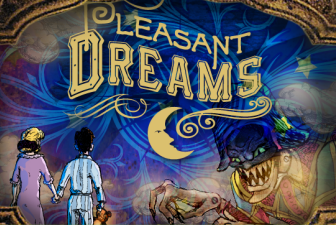You are asleep, drifting aimlessly through a precious landscape of teddy bears and twinkling stars. All is soft and quiet and peaceful . . . but you can’t help but feel the first inkling of . . . dread? Darkness? You can’t put your finger on it just yet, but the gentle landscape of your dream is shifting. Something is off. The colors are just a smidge darker. Your movements are just a bit slowed. You try to turn, to go back to the rolling dreamfields, but your legs will only move forward.
Up ahead, a hill rises and you walk up it. Your lips part and you try to speak, to yell, but your voice gets lost in the heavy air. A figure, short and misshapen, is awaiting your approach at the crest of the hill. Everything is shadow and dread. Fear is so thick in your throat that you can’t even swallow against it. You don’t know what that figure is, but it’s bad, wrong. It begins moving toward you, arms outstretched. It’s your teddy bear, it’s body now host to a hideous arachnoid beast. You suck in a deep breath and scream, only to find your eyes open, your heart beating against your ribs. Awake. It was a dream. Only a dream . . .
Such a cute bear…
Prototype Shown
Pleasant Dreams is a card game by Aerjen Tamminga for 1-2 players that delves into the ethereal realm of dreaming. To begin, each player is given a Wakefulness card to track just how deep their sleep is. The card is numbered from 0 (fast asleep, dreaming of kittens and ice cream) to 5 (waking up screaming), and throughout the game players use cards to move themselves up and down this track. It’s encouraged that most players begin on step one, though more experienced players looking for a challenge can start further down the track if they so desire. Each player also gets a Barrier card, which can cancel out negative effects, and a Premonition card, which can allow them to view the top three cards of the deck.
Pleasant Dreams is played primarily using a single deck consisting of two main card types: those that lull you into sweet, wonderful dreams, and those that draw you into nightmares. On their turn, a player states how many cards they will draw from the deck (between one and five). Some of the cards will move their wakefulness down toward 5 and some will move it up toward 0. Cards are then resolved in reverse order.
That part is pretty luck-based, but here’s where the strategy comes in. Certain cards have a little arrow symbol in the top corner. After these cards are resolved, the active player can choose to flip them over, revealing the effect on the opposite side. Sometimes it’s good, and sometimes it’s bad. Either way, though, that player must insert it back into the deck in the location of their choice.
This is where it pays to know thy enemy. The more you understand a player’s style, the better you can predict how many cards they’ll choose to draw next and, therefore, where you should slide in that horrible card you just flipped. If they’re the kind who always draw three cards, for instance, you’ll be safe putting it just beneath the second card. But if they wise up and only choose to draw two cards, you’ll have to draw the card yourself and force your own dreams into dark alleys.
“All I have to do is divine from what I know of you…”
The game continues until one player reaches 5 on the wakefulness card or until a player draws the final card of the deck. In that case, the player who drew the final card wins – so keep an eye on the size of the deck toward the end.
Make it stop!
Prototype Shown
Pleasant Dreams isn’t a complicated game, but it’s also not quite as simple as it’s tarot-style art and rapid play time suggest. There’s a layer or two of strategy beneath it’s dreamy exterior and a good deal of that centers on knowing your opponent and their typical playstyle. At the same time, you can’t make your own upcoming moves too predictable. It takes a level of skill and foresight to know where to slip your cards in, be they good or bad, and when to time your change up normal habits.
Players who are looking for a heavy game won’t have enough here to chew on, but Pleasant Dreams is ideal for anyone wanting a light game that retains a level of strategy and deduction, and you can check it out over on Kickstarter.
The game is easy to learn, very portable, and is incredibly quick whether you’re playing with someone else or going solo. The concept has you explore the depths of your own dreamland, hoping not to run afoul of anything too too scary as you try to make your way back to a happy, restive state. Part of the game’s uniqueness also ties into the idea of ‘playing the other player’, trying to gauge what their next move will be. Just like a real dream, though, one blink and the game could be over. If things are going poorly for you, though, perhaps that’s not a bad thing.
Photo Credits: Princess Bride by MGM Studios.
